CES 2009 - TV Trends, WirelessHD, 240Hz and Netbook Pricing
by Anand Lal Shimpi & Manveer Wasson on January 12, 2009 12:00 AM EST- Posted in
- Trade Shows
More TV Trends: Thin, Local Dimming and 240Hz
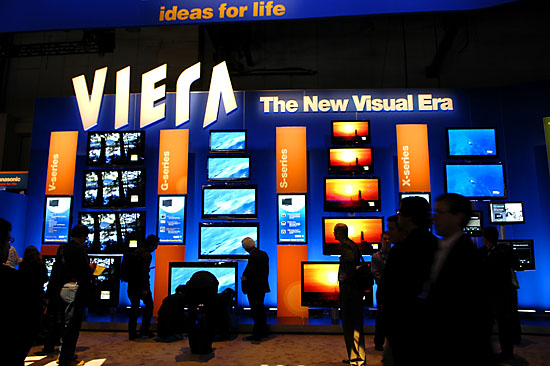
Panasonic demonstrated a 1” thick plasma display as well as a prototype 1/3” plasma at this year’s CES.
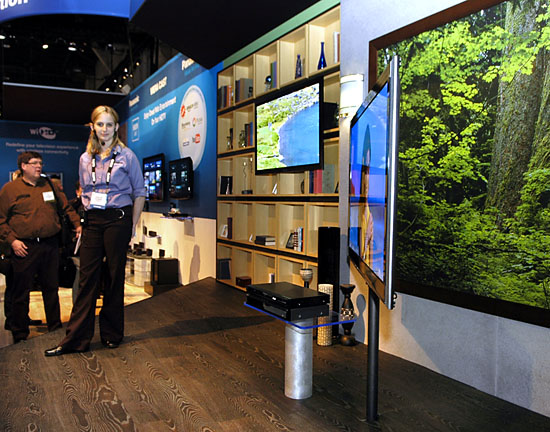
Thin is in. WirelessHD should eventually help reduce the thickness of TVs as well.
We also saw a brightness and power consumption demo similar to what was shown off last year. In short, brightness per watt is improving with newer panels over older ones. If you have a plasma or LCD that’s only 3 or 4 years old, you’ll most likely see a huge improvement either in brightness or power consumption (or both) by moving to a newer panel.
The LCD vs. Plasma debate basically boils down to this: LCDs have brighter whites and plasmas have deeper blacks (there’s also the glare issue but let’s ignore that for now). Given the lower cost of LCD panels at smaller, more mainstream sizes, TV makers are often looking for ways to improve black levels without sacrificing white levels.
If you could control the backlight of individual areas of the panel, you could turn it off completely in dark areas and leave it on in white areas. The concept and technology has been around for a while, but what we needed was rear-lit LED backlighting to make it affordable.
Instead of the panel being lit from the sides, with a rear-lit (or full matrix) backlight it’s illuminated from behind using many LEDs. With a true backlight composed of many LEDs it’s easy to dynamically turn on/off groups of them depending on the scene. The result is better black levels without sacrificing the bright whites that make LCDs so desirable. We saw similar technologies demonstrated last year in the Panasonic and Pioneer plasmas at CES 2008.
Another potential benefit of full matrix LED backlighting is what Toshiba and some other manufacturers are calling the 240Hz effect. Last year we saw the beginnings of a move to 120Hz LCDs, which you may remember isn’t LCD panels with 120Hz refresh rates. There are only 60 frames of data displayed, the data in between two frames is simply interpolated on the fly effectively giving you 120 frames per second (but from only 60 frames worth of data).
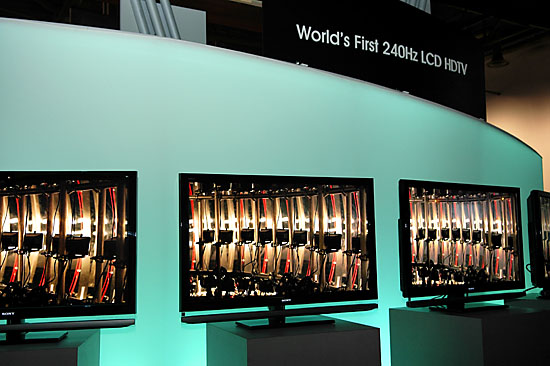
The 240Hz panels don’t interpolate a second time, instead some use a technique called backlight scanning. You still perform the same 120Hz effect but you turn portions of the backlight on and off very quickly to make for 240 different frames per second. Sets that support 240Hz in this manner obviously can also support local dimming, but it’s unclear if they can do both at the same time.
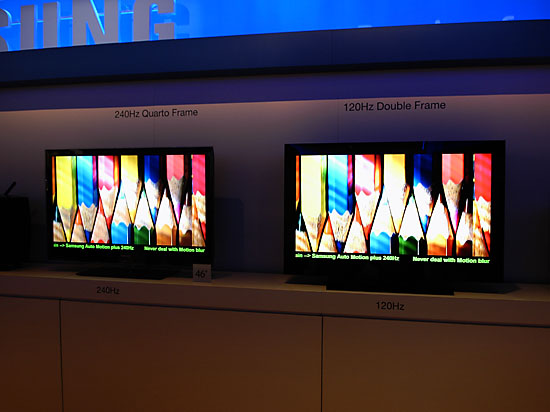
Samsung uses interpolation on its 240Hz TVs
Some manufacturers are interpolating a second time, so you get one original frame and 3 interpolated frames, at a rate of 240Hz without doing any backlight trickery. On paper this sounds like a better implementation however the displays that use additional interpolation also lack local dimming. Both Samsung and Sony generate 240 frames using interpolation and both companies use edge-lit LED backlights. Interestingly enough, Samsung used a rear-lit LED backlight in last year’s model with local dimming support and moved away from it this year.
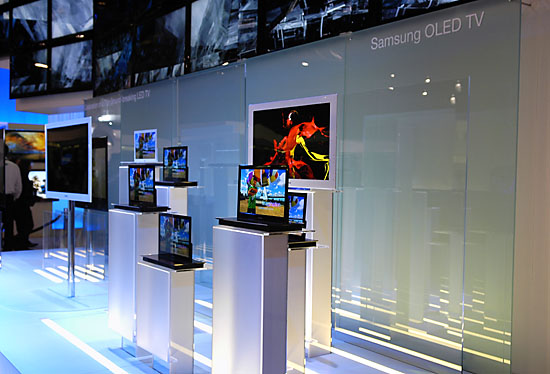
OLED TVs were at CES, but still not ready for mainstream consumption yet
Internet Enabled TVs
We saw streaming internet content in CE products in early forms at last year’s CES. This year, companies have forged partnerships with the likes of Netflix, YouTube, and Yahoo in order to provide content directly to TVs and Blu-Ray players. Unfortunately, each CE company has forged alliances with different content providers. So while Sony can provide you with YouTube and Amazon Video streaming, it will not provide streaming HD Netflix movies like LG and Samsung can.
Although the idea of not needing to hook up a PC to your TV to view your favorite YouTube videos is nice, locking content providers to specific CE companies certainly hinders its usefulness. Streaming content is probably not a deal breaker for most consumers’ CE purchases.










30 Comments
View All Comments
superandroid - Thursday, January 15, 2009 - link
i think that the 60 ghz microwave frequency will be hazardous to the human brain because it can easily penetrate the human body.3DoubleD - Thursday, January 15, 2009 - link
That is incorrect. 60 GHz cannot easily penetrate the human body, which would actually be more reason to fear it than if it could simply just pass through. However, 60 GHz photons have such little energy that they can't possibly negatively influence the human body, just like all other radio communication and microwaves. Now if the transmitter is powerful enough that the absorbed energy turns into a significant amount of heat (eg a microwave oven), then you should worry about cooking yourself. Considering a microwave oven is ~1000 Watts and this transmitter will likely be on the order of a few hundred or thousand milliwatts, you have nothing to fear.michael145 - Tuesday, January 13, 2009 - link
Man, imagine running Crysis at 4K's resolution with 4AA/4AF on...What machine do you need?
fly123 - Tuesday, January 13, 2009 - link
anybody know if this will be usable with a media server, or is the wirelesshd consortium locking it down to oem because of drm fear?I mean, do any of you know if there are any plans for making a plugin device that one can plug into a pc and screen of own chosing?
Ive looked at the consotiums website, but havnt been able to find anything usefull.
Milleman - Monday, January 12, 2009 - link
"Your inputs are connected wirelessly to the TV via a 60GHz signal..."That's a lot of Hertz. I didn't think 60 GHz was possible to produce with todays semiconductor technology.
Stampede103 - Monday, January 12, 2009 - link
Does any one know of a netbook that is using Nvidia's Tegra 600 line of processors?sprockkets - Monday, January 12, 2009 - link
When a netbook can play YouTube on the HQ setting without stuttering, I'll get one.I still like the HP one with the nice sized keyboard. If they used a Nano or Dual core Atom with Ion, this problem would be solved.
Denithor - Monday, January 12, 2009 - link
Really?
Jynx980 - Monday, January 12, 2009 - link
I thought that was really high as well. The closest thing I know of would be wireless phones with 5.8 GHz. This is more than 10x that amount so it seemed out of whack.I assume that WirelessHD will support HDCP, but it only states that it supports Digital Transmission Content Protection (DTCP) in the wiki link. Another protection to worry about.
I like reading about TV stuff. Was there a Vizio booth at all? I would like to see their lineup for '09. Although the line is blurred more each year between TV and PC monitors, I wish there were more focus on PC monitors. It doesn't seem like there has been much innovation in this area.
3DoubleD - Monday, January 12, 2009 - link
http://en.wikipedia.org/wiki/Radio_frequency">http://en.wikipedia.org/wiki/Radio_frequencyhttp://en.wikipedia.org/wiki/WirelessHD">http://en.wikipedia.org/wiki/WirelessHD
Both pages agree that not only is it possible, but the article is correct. This frequency range has (relatively) high attenuation in Earth's atmosphere and (usually) requires line-of-sight so it is really limited in terms of application. It should really make connecting devices much more easy. Apparently the first devices are supposed to support up to 10 feet without line-of-sight. They chose the extreme high frequency band because the strong absorption with oxygen molecules in the air will protect copyright owners by preventing you neighbors from using the signal. A competing technology uses bandwidth around 5 GHz to achieve 250 mbps throughput, but I guess copyright holders were a bit worried with the transmission distance.